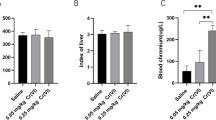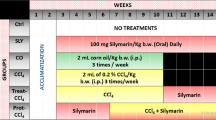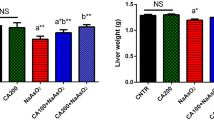Abstract
Cerium has been demonstrated to damage liver of mice, but very little is known about the molecular mechanisms underlying the mouse liver apoptosis. In order to understand the liver injury induced by intragastric administration of cerium chloride (CeCl3) for 60 consecutive days, the hepatocyte ultrasrtucture, various oxidative stress parameters, and the stress-related gene expression levels were investigated for the mouse liver. The results demonstrated that CeCl3 had an obvious accumulation in the mouse liver, leading to a classical laddering cleavage of DNA and hepatocyte apoptosis. CeCl3 significantly promoted the accumulation of reactive oxygen species and inhibited the stress-related gene expression of superoxide dismutase, catalase, glutathione peroxidase, metallothionein, heat-shock protein 70, glutathione-S-transferase, P53, and transferring, and it effectively activated the cytochrome p450 1A. It implied that CeCl3 resulted in apoptosis and alteration of expression levels of the genes related with metal detoxification/metabolism regulation and radical scavenging action in mice.





Similar content being viewed by others
References
Barata C, Lekumberri I, Vila-Escale M, Prat N, Porte C (2005) Trace metal concentration, antioxidant enzyme activities and susceptibility to oxidative stress in the tricoptera larvae Hydropsyche exocellata from the Llobregat river basin (NE Spain). Aquat Toxicol 74:3–19
Basu A, Chakrabarty K, Chatterjee GC (1984) The effects of lanthanum chloride administration in newborn chicks on glutamate uptake and release by brain synaptosomes. Toxicol Lett 20:303–308
Beauchamp C, Fridovich I (1971) Superoxide dismutase: improved assays and assay applicable to acrylamide gels. Anal Biochem 44:276–286
Beere HM, Wolf BB, Cain K, Mosser DD, Mahboubi A, Kuwana T, Tailor P, Morimoto RI, Cohen GM, Green DR (2000) Heat-shock protein 70 inhibits apoptosis by preventing recruitment of procaspase-9 to the Apaf-1 apoptosome. Nat Cell Biol 2:469–475
Brouwer M, Winge DR, Gray WR (1989) Structural and functional diversity of copper- metallothioneins from the American lobster Homarus americanus. J Inorg Biochem 35:289–303
Buege JA, Aust SD (1978) Microsomal lipid peroxidation. Methods Enzymol 52:302–310
Choudhuri S, McKim JM, Klaassen CD (1993) Differential expression of the metallothionein gene in liver and brain of mice and rats. Toxicol Appl Pharmacol 119(1):1–10
Claiborne A (1985) Catalase activity. In: Greenwaid RA (ed) Handbook of methods for oxygen free radical research; CRC Press. Boca Raton, FL
Corpas F, Palma PM, Sandalio LM, Lopez-Huertas E, Romero-Puertas MC, Barroso JB (1999) Purification of catalase from pea leaf peroxisomes: identification of five different isoforms. Free Radical Res 31:235–241
De Jongh J, DeVito M, Nieboer R, Birnbaum L, Van den Berg M (1995) Induction of cytochrome P450 isoenzymes after toxico-kinetic interactions between 2,3,7,8-tetrachlorodibenzo-p-dioxin and 2,2′,4,4′,5,5′-hexachlorobiphenyl in the liver of the mouse. Fund Appl Toxicol 25:264–270
Fan GQ, Yuan ZK, Zheng HL, Liu ZJ (2004) Study on the effects of exposure to rare earth elements and health-responses in children aged 7–10 years. J Hyg Res 33:23–28
Fei M, Li N, Liu J, Gong XL, Duan YM, Zhao XY, Wang H, Hong FS (2010) Oxidative stress in the liver of mice caused by lanthanoides. Biol Trace Element Res. doi:10.1007/s 12011-010-8638-9
Feng ZX, Zhang SG, Yang KY, Ni JZ (1996) Influence of intraperitoneal injection of rare earth compounds on the activity of antioxidant enzymes and the level of lipid peroxidation in mice livers. J Rare Earth 14:66–69
Feng JH, Li XJ, Pei FK, Chen X, Li SL, Nie YX (2002) 1H NMR analysis for metabolites in serum and urine from rats administrated chronically with La(NO3)3. Anal Biochem 301:1–7
Feng LX, Xiao HQ, He X, Li ZJ, Li FL, Liu NQ, Chai ZF, Zhao YL, Zhang ZY (2006a) Long-term effects of lanthanum intake on the neurobehavioral development of the rat. Neurotoxicol Teratol 28(1):119–124
Feng LX, Xiao HQ, He X, Li ZJ, Li FL, Liu NQ, Zhao YL, Huang YY, Zhang ZY, Chai ZF (2006b) Neurotoxicological consequence of long-term exposure to lanthanum. Toxicol Lett 165:112–120
Fridovich I (1978) The biology in oxygen radical. Science 201:875–880
Fukuchi K, Tomoyasu S, Tsuruoka N, Gomi K (1994) Iron deprivation-induced apoptosis in HL-60 cells. FEBS Lett 350:139–142
Greisberg JK, Wolf JM, Wyman J, Zou L, Terek RM (2001) Gadolinium inhibits thymidine incorporation and induces apoptosis in chondrocytes. J Orthop Res 19:797–801
Hayes JD, Flanagan JU, Jowsey IR (2005) Glutathione transferases. Annu Rev Pharmacol Toxicol 45:51–88
Hissin PJ, Hilf R (1976) A fluorometric method for determination of oxidized and reduced glutathione in tissues. Anal Biochem 74:214–226
Hong HN, Kim HN, Park KS, Lee SK, Gu MB (2007) Analysis of the effects diclofenac has on Japanese medaka (Oryzias latipes) using real-time PCR. Chemosphere 67:2115–2121
Hu Z, Richter H, Sparovek G, Schnug E (2004) Physiological and biochemical effects of rare earth elements on plants and their agricultural significance: a review. J Plant Nutr 27:183–220
Implay JA (2003) Pathways of oxidative damage. Annu Rev Microbiol 57:395–418
Jacques-Silva MC, Nogueira CW, Broch LC, Flores EM, Rocha JBT (2001) Diphenyl diselenide and ascorbic changes deposition of selenium and ascorbic in liver and brain of mice. Pharmacol Toxicol 88:119–125
Kawagoe M, Hirasawa F, Wang SC, Liu Y, Ueno Y, Sugiyama T (2005) Orally administrated rare earth element cerium induces metallothionein synthesis and increases glutathione in the mouse liver. Life Sci 77:922–937
Ke LD, Chen Z (2000) A reliability test of standard-based quantitative PCR: exogenous vs endogenous standards. Mol Cell Probes 14(2):127–135
Leaver MJ, Wright J, George SG (1997) Structure and expression of a cluster of glutathione S-transferase genes from a marine fish, the plaice (Pleuronectes platessa). Biochem J 321(Pt 2):405–412
Lewis NA, Williams TD, Chipman JK (2006) Functional analysis of a metal response element in the regulatory region of flounder cytochrome P450 1A and implications for environmental monitoring of pollutants. Toxicol Sci 92:387–393
Li HM, Niki T, Taira T, Iguchi-Ariga SM, Ariga H (2005) Association of DJ-1 with chaperones and enhanced association and colocalization with mitochondrial Hsp70 by oxidative stress. Free Radical Res 39:1091–1099
Li ZF, Wu HF, Zhang XY, Li XJ, Liao PQ, Li WS, Pei FK (2006) Investigation on the acute biochemical effects of light rare earths (lanthanum and cerium) by NMR-based metabonomic approaches. Chem J Chin Univ 27:438–442
Liao PQ, Wu HF, Zhang XY, Jing LX, Feng LZ, Sheng LW, Wu YJ, Pei FK (2006) Comparative investigation on acute biological effect of lanthanum and cerium by MAS 1H NMR-based metabonomic approach. Chem J Chin Univ 27:1448–1452
Liao PQ, Zhang XY, Wang T, Sheng LW, Wu YJ, Li XJ, Ni JZ, Pei FK (2008) Studies on the acute biochemical effects of Nd(NO3)3 by nuclear magnetic resonance-based meatbonomics. Chin J Anal Chem 36:426–432
Liu WH, David A (2002) Saint Validation of a quantitative method for real time PCR kinetics. Biochem Biophys Res Commun 294:347–353
Liu HX, Yuan L, Yang XD, Wang K (2003) La3+, Gd3+ and Yb3+ induced changes in mitochondrial structure, membrane permeability, cytochrome c release and intracellular ROS level. Chem-Biol Interact 146:27–37
Liu J, Li N, Ma LL, Duan YM, Wang J, Zhao XY, Hong FS (2010) Mechanism of the splenic injury in mice caused by lanthanides. J Alloys Compounds 489:708–713
Livak KJ, Schmittgen TD (2001) Analysis of relative gene expression data using real-time quantitative PCR and the 2(-Delta Delta C(T)) method. Methods 25:402–408
Lowry OH, Rosebrough NJ, Farr AL, Randall RJ (1951) Protein measurement with the folin phenol reagent. J Biol Chem 193:265–275
Marubashi K, Hirano S, Suzuki KT (1998) Effects of intratracheal pretreatment with yttrium chloride (YCl3) on inflammatory responses of the rat lung following intratraccheal instillation of YCl3. Toxicol Lett 99:43–51
Mayer MP, Bukau B (2005) Hsp70 chaperones: cellular functions and molecular mechanism. Cell Mol Life Sci 62:670–684
McKenna IM, Gordon T, Chen LC, Anver MR, Waalkes MP (1998) Expression of metallothionein protein in the lungs of Wistar rats and C57 and DBA mice exposed to cadmium oxide fumes. Toxicol Appl Pharmacol 153(2):169–178
Mizgerd JP, Molina RM, Stearns RC, Brain JD, Warner AE (1996) Gadolinium induces macrophage apoptosis. J Leukoc Biol 59(2):189–195
Ni JZ (2002). Bioinorganic chemistry of rare earth elements. Science Press, Beijing, pp 285–337 (in Chinese)
Nourooz-Zadeh J, Tajaddini-Sarmadi J, Wolf SP (1994) Measurement of plasma hydroperoxide concentrations by the ferrous oxidation-xylenol orange assay in conjunction with triphenylphosphine. Anal Biochem 220:403–409
Olafson RW, McCubbin WD, Kay CM (1988) Primary- and secondary-structural analysis of a unique prokaryotic metallothionein from a Synechococcus sp. cyanobacterium. Biochem J 251:691–699
Oliveira CP, Lopasso FP, Laurindo FR, Leitao RM, Laudanna AA (2001) Protection against liver ischemia-reperfusion injury in rats by silymarin or verapamil. Transplant Proc 33:3010–3014
Paglia DE, Valentine WN (1967) Studies on the quantitative and qualitative characterization of erythrocyte glutathione peroxidase. J Lab Clin Med 70:158–169
Preeta R, Nair RR (1999) Stimulation of cardiac fibroblast proliferation by cerium: a superoxide anion-mediated response. J Mol Cell Cardiol 31:1573–1580
Ren XY, Zhou Y, Zhang JP, Feng WH, Jiao BH (2003) Expression of metallothionein gene at different time in testicular interstitial cells and liver of rats treated with cadmium. World J Gastroentrrol 9(7):1554–1558
Reuveni R, Shimoni M, Karchi Z, Kuc J (1992) Peroxidase activity as a biochemical marker for resistance of muskmelon (Cucumis melo) to seudoperno spora cubensis. Phytopathology 82:749–753
Roesijadi G (1992) Metallothioneins in metal regulation and toxicity in aquatic animals. Aquat Toxicol 22:81–114
Sabbioni E, Pietra R, Gaglione P, Vocaturo G, Colombo F, Zanoni M (1982) Long-term occupational risk of rare earth pneumoconiosis. Sci Total Environ 26:19–32
Shen ZG, Zhang ZX, Huang HX, Zhang JZ, Leng HY, Yang YS (2001) Effect of Ce3+ on reactive oxygen species in cells. J Hyg Res 30:275–277
Shi WL, Shen XY, Ma XY (2006) Effects of samarium on liver and kidney of rats. J Rare Earth 24:415–448
Truksa J, Kovar J, Valenta T, Ehrlichova M, Polak J, Naumann PW (2003) Iron deprivation induces apoptosis independently of p53 in human and murine tumour cells. Cell Prolif 36:199–213
Wahba ZZ (1994) Absence of changes in metallothionein RNA in the rat testes made refractory to cadmium toxicity by zinc pretreatment. Hum Exp Toxicol 13(1):65–67
Wang K, Li RC, Cheng Y, Zhu B (1999) Lanthanides—the future drugs? Coord Chem Rev 190:297–308
Welch S (1992) Transferrin: the iron carrier. CRC Press, Boca Raton, FL
Wu HF, Zhang XY, Li XJ, Wu YJ, Pei FK (2005) Acute biochemical effects of La(NO3)3 on liver and kidney tissues by magic-angle spinning 1H nuclear magnetic resonance spectroscopy and pattern recognition. Anal Biochem 339:242–248
Xia Q, Chen D, Liu YR, Chen AJ (2006) Effect of mixed rare earth oxide “changle” on rat liver. Chin Rare Earth 27:76–78 (abstract in English)
Xu X, Zhu W, Wang Z, Witkamp GJ (2002) Distribution of rare earths and heavy metals in field-grown maize after application of rare earth-containing fertilizers. Sci Total Environ 293:97–105
Zhang S, Shan X (2001) Speciation of rare earth elements in soil and accumulation by wheat with rare earth fertilizer application. Environ Pollut 112:395–405
Zhang H, Feng J, Zhu WF (1999) Characteristic of rare earth distribution in biologic chains of rare earth-rich background regions. J Chin Rare Earth Soc 174(4):365–368
Zhang YL, Zhang X, Fei XC, Wang SL, Ga HW (2010) Binding of bisphenol A and acrylamide to BSA and DNA: insights into the comparative interactions of harmful chemicals with functional biomacromolecules. J Hazard Mater 182:877–885
Zhu WF, Xu SQ, Zhang H, Shao PP, Wu DS, Yang WJ, Feng J (1996) Investigation of children intelligence quotient in REE mining area: bio-effect study of REE mining area in South Jiangxi. Chin Sci Bull 41:914–916
Zhu WF, Xu SQ, Shao PP, Zhang H, Wu DS, Yang WJ, Feng J (1997) Bioelectrical activity of the central nervous system among populations in a rare earth element area. Biol Trace Element Res 57:71–77
Acknowledgments
This work was supported by the National Natural Science Foundation of China (grant No. 30901218), the “Chun-Tsung scholar” Foundation of Soochow University, and the New Ideas Foundation of Student of Soochow University (grant No. 5731511410).
Author information
Authors and Affiliations
Corresponding author
Rights and permissions
About this article
Cite this article
Zhao, H., Cheng, J., Cai, J. et al. Liver Injury and Its Molecular Mechanisms in Mice Caused by Exposure to Cerium Chloride. Arch Environ Contam Toxicol 62, 154–164 (2012). https://doi.org/10.1007/s00244-011-9672-0
Received:
Accepted:
Published:
Issue Date:
DOI: https://doi.org/10.1007/s00244-011-9672-0




